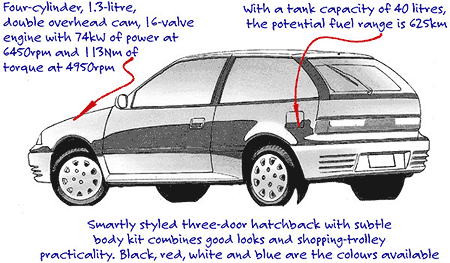BY MALCOLM LIVERMORE | 11th Jul 2003

Despite being based on the lowly, lightweight and front-wheel drive 1984-1989 SA-series Swift hatch, the GTi instantly gained a cult following among city-based boy-racer types.
With the GTi's fierce 1.3-litre, twin cam, 16-valve, four- cylinder engine, the scalding Swift loved to rev all the way to high-heaven - which is what's expected from a Japanese motorcycle manufacturer.
In January, 1989, the SF-series Swift was launched. Bigger and roomier in every dimension, the newer Swift GTi addressed many of the tight packaging problems of the previous edition.
The Swift's decade-old styling - an American design based on a Chevrolet concept car - is nevertheless neat, weathering the vagaries of fashion well.
The spunky three-door shape has plenty of youth appeal. With its subtle body kit and painted skirts and bumpers, the GTi still looks suitably sporty while the aerodynamic drag coefficient of 0.32 is competitive 10 years on.
But the sweet engine remains the Swift GTi's calling card.
Virtually unchanged since its memorable debut, the 1.3-litre screamer had been fine-tuned in the SF-series to provide more torque over a broader rev-range.
Maximum power is 74kW at a peaky 6450rpm with the tachometer redlined to delight enthusiasts at a motorcycle-like 8000rpm, although in reality a rev-limiter kicks-in at 7500rpm.
Considering the size of the engine, the maximum torque figure of 113Nm at 4950rpm is acceptable.
To put the GTi engine's remarkable efficiency in context, the similarly sized 1.3-litre Toyota Starlet produces just one Newton-metre less torque but a sizeable 19kW less power.
Now consider that the Starlet weighs just one kilogram less at 835kg and you can see why the Swift delivers slingshot performance, spiced with an addictive wail.
With the engine just bursting to please, excellent fuel economy is a surprising bonus. The official figures are 7.3L/100km for the city cycle and 5.6L/100km on the open road.
A precise and sweet shifting five-speed manual gearbox - no auto was available - helps make the most of the many gearchanges required to keep the little Suzi's engine on the boil, but it all spills over once a corner is hit.
The GTi's unassisted rack and pinion steering loads up quite alarmingly entering a corner at speed, meaning the wheel becomes heavy and cumbersome.
Plus it lacks feel and precision, unacceptable in a car with a sporting edge. Small bumps unsettle the GTi, making the already hard ride feel jiggly and nervous.
Brakes that do not inspire confidence top the GTi's trifecta of disappointing chassis dynamics. They tend to fade quite rapidly despite being a four-wheel disc set-up.
Although little has changed externally on the Swift GTi over the years, a thorough cabin make-over occurred in late 1991, heralding the SF Series II GTi.
The shiny plastics, off-beat instrumentation and minimalist approach of the 1989-1991 Swift dashboard give the earlier models a degree of individuality. They are well made, quite tough and in character with the GTi.
The curvy and integrated facia of latter models is remarkable only for its completely generic nature. It really could be out of any contemporary Japanese small car. At least the interior is well screwed together and is less susceptible to rattles.
There is space aplenty for tall drivers although they will be aware of the interior's limited width. Headroom is fine in the front if a little tight in the back, but it is a big improvement over the first generation Swift models.
The front seats with their sporty look and purposeful side bolstering are neither very comfortable or supportive. The driving position is good with adjustable steering and big glass areas affording commanding views in all directions.
The rear is a little cramped with passengers suffering from a bench that is flat and unsupportive.
The GTi's mundane hatchback origins are betrayed by the practical split/fold rear seats and reasonably large storage area behind. The GTi becomes quite the zippy load-carrier if the seats are folded flat.
Considering the price of a new Swift GTi - around $20,000 compared to base model Swift's $12,000 - the equipment levels were not particularly high.
Do not expect central locking, power steering or factory-fitted alloy wheels while power windows were fitted as standard only on later models.
The Swift GTi has big time boy-racer appeal. The young male buyer profile reflects this as do many GTis across Australia that have heroically stood a good, hard thrashing.
Consequently, younger male drivers will find insurance premiums for the GTi very high compared to the rest of the Swift range.
Inexperience in the wet, lack of traction from tired tyres and a light rear end have swiftly led many GTis into scrapes, bingles and crashes.
Watch for evidence of major accident damage under the bonnet and in the way the front-wheel drive Suzuki tracks behind the wheel at speed.
Considering how enthusiastically they are driven, the Swift GTi has a remarkable reliability record. They really are resilient to abuse, although not totally immune.
Wear and tear on the brakes, driveline and engines are common so a thorough mechanical check-up is essential.
If caned unsympathetically, the Swift's manual gearbox synchromesh can wear prematurely.
Like all high-revving Japanese multi-valve units, the 1.3-litre engine needs its timing belt service intervals adhered to. In the Suzi's case that is every 80,000 kilometres.
A special oil - such as Caltex GTX3 - is necessary. As per usual, a thorough service record is desirable for peace of mind.